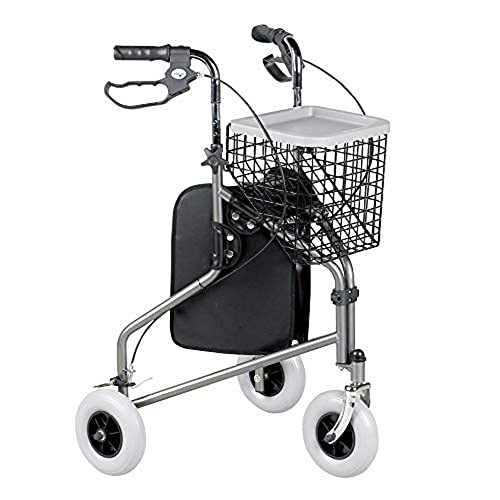What Is a Type 3 wheel rollator with brakes Rollator Walker?
Unlike a standard walker, it has a seat that flips up when it is not being used. This can make it easier to move around in tight spaces.
Other features to consider include hand brakes that are easy to use, and an ergonomic seat. You can find walkers that have additional accessories like a tray or basket.
Frame
A rollator is a great alternative to walkers that are traditional. It helps people with mobility issues to walk at a normal pace. They are more adaptable than standard walkers because they can be maneuvered around tight spaces without being a threat to stability. There are heavy-duty models with three-wheeled and four-wheeled rollators that can accommodate users of larger sizes.
When choosing a rollator you should pay attention to the frame's design and materials. The wheels should be made of a strong, comfortable, and gripping material like rubber or polyurethane. Also, a padded seat helps you remain at ease while walking for long distances. You might also require a seat and handlebar that can be adjusted to your height, according to your requirements.
The brakes that are push-down are an additional important feature. They are easy to use since all you have to do is press down on the brake levers to stop the walking. Contrary to the cable-free brakes they do not require cables that could get stuck on things like knobs on doors and cabinet handles.
The neXus 3 wheeled rollator with seat is among of the best rollators that are available. It has a frame that folds cross-folding, which means that it can fold from side to side to fit into the trunk of a car or behind seat. When folded, it stands on its own and has a basket in the front to make it easy to access. The neXus 3 wheel rollators with seat is extremely light, makes it simple to store and move.
If you're shopping for a rollator with three wheels it is crucial to choose one that is small and fits through the doors of your home. Most models are between 18 and 13 inches wide which is the ideal size for adults. You may also be looking for a bariatric-style rollator that is larger and can support a weight of 400-500 pounds. These are usually reinforced with steel frames that are sturdy and have seats that are wider to accommodate larger users. They also have large wheels that offer more support for rough terrain. They are also easier to maneuver in tight spaces than four-wheeled models.
Seat
While standard walkers are a great choice for those who require stability while standing and want to remain in a more natural walking posture Rollators are a great option for people who have greater mobility. They have more wheels and are lighter than traditional walkers, which makes them more portable and suitable for outdoor use. They can also be folded which makes them easy to keep in your car or at home.
The most suitable rollator for seniors will come with an adjustable height for the seat and handlebars that can be adjusted to fit different body types. Some models have a built-in backrest. Most models feature brake levers that are installed under the handles and can be easily operated and accessed. These brakes help you remain hands free of the steep slopes and obstacles.
A walker that is of good quality is one that has a comfortable backrest to ensure your ease of use. The mobility device should come with a zippered bag to store your personal belongings while using it. The pouch should be secured to the walker even when it is folded so that you don't lose it. Some models come with a cross-folding framework, which allows the walker to be folded from side to side quickly and with less storage space. The neXus 3 is a fantastic illustration of this unique design. It also has a cushioned back strap for the neXus that can flip to allow for two-position seating and an adjustable front fork with double bearings to ensure smooth rolling.
Consider the size of the seat when selecting a walker. Adult-sized seats vary between 13 and 18 inches, while models for bariatrics have a larger seat to support larger users. Most walker manufacturers will indicate the maximum weight capacity of their products, so you'll know whether the model you choose will comfortably meet your needs.
The brakes of a rollator are controlled by the wheels of the frame, while the standard walker has hand-operated breaks. The wheels are typically larger than the ones on the standard walker, which means they can better handle rough terrain and obstacles. The wheels on a four-wheel walker can also rotate, making it easier to turn around corners.
Handles
A three-wheel rollator is an ideal mobility aid for seniors with problems with balance, strength or endurance who require more support than a folding cane, but don't require a built-in seat to sit on. It is easily assembled and folds down by using one hand for quick storage and transportation. It can be carried into and out of the vehicle with less effort when it's folded. It is packed with a bag that can be attached and removed quickly as required. It is also available in three different heights to accommodate different types of users.
The ergonomic handgrips are designed so that they prevent blisters and provide a firm and comfortable grip. Its cable-free braking system ensures that you are able to stop with confidence power. Most models come with a padding for the seat backrest to provide extra comfort when you are seated.
If you opt for a model with four wheels the wheels are generally larger than those of a standard walker, and can aid you in traversing more difficult terrain. They also have greater capacity for weight than a standard walker. Some of them even come with a flip-up seat that offers you the option to sit down during longer walks.
When selecting a two-wheeled rollator Look for one that has front wheels that roll, and back glides that control the motion of the device. This type of design lets you maintain a more natural walking style without needing to lift the rollator every when you walk.
For indoor use, go for a walker that has small wheels to accommodate tight spaces. Consider the size of the handles and whether they are adjustable. This can be a great feature if you're taller as you might need the handles to be higher so that you can comfortably reach them.
If you plan to use your rollator predominantly in urban settings, look for a model that features curb climbers. This will let you navigate curbs and bumps with ease. Furthermore, the majority models of these walkers have adjustable brakes to help you slow down when you are going downhill.
Brakes
The brakes of a rollator can be located on the handles. They prevent the walker from rolling when you stop. They are usually locked by default, but are released when the user applies pressure to the handle grips. This will ensure that the walker remains in place whether you're sitting or standing. It also improves the stability of the walker when moving around.
The handles of a rollator are typically made from plastic or foam and have a variety of sizes to accommodate different hand sizes. Some users might prefer a larger grip for greater comfort, whereas others may benefit from a softer material to prevent hand fatigue or a slippy grip. You can replace the grips on a rollator by ones that are more comfortable for you, or you can purchase a custom-designed pair grips that are designed to fit the specific walker.
While traditional walkers are equipped with legs that can snag on obstacles or slops in the ground, a rollator has been designed to be used on uneven surfaces and works quite well on sidewalks and walking trails. It is recommended that you take your walker on uneven surfaces to ensure that the wheels are able to move over them, so that you don't get stuck or losing control of the walker.
Most walker and rollator models are built to accommodate users up to 250 lbs in weight. However, it is recommended that you have an examination of your body before you choose the type of mobility aid that is best for you. You can visit a showroom of a dealer to get your height and weight measured, or measure yourself at home using the aid of a tape measure. Also, you should have your hands measured for an ideal fit with the grips of a walker, or the handles of a rollator, to make sure they are comfortable and that you are able to easily apply pressure when required.
 If you experience any difficulty with the brakes on your walker, it's essential to find the cause and fix the issue as soon as possible. The most frequent problem is that the brake adjustment knob or screw has been tightened to much, resulting in the walker not being able to apply any pressure when the brakes are engaged. This can be resolved by loosening the nut and then applying pressure to see how the brakes respond. You can tighten the knob or screw again if necessary. Repeat this process until you are satisfied with your desired results.
If you experience any difficulty with the brakes on your walker, it's essential to find the cause and fix the issue as soon as possible. The most frequent problem is that the brake adjustment knob or screw has been tightened to much, resulting in the walker not being able to apply any pressure when the brakes are engaged. This can be resolved by loosening the nut and then applying pressure to see how the brakes respond. You can tighten the knob or screw again if necessary. Repeat this process until you are satisfied with your desired results.
